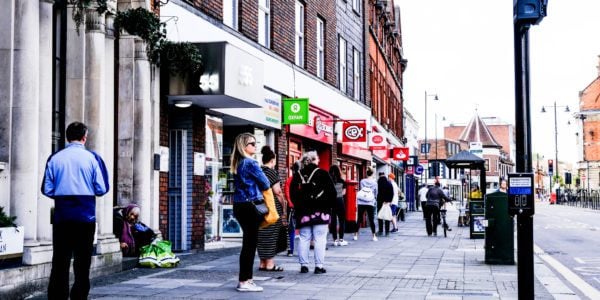
13/10/20
4 min read
Government borrowing this year will reach a level never before seen in the UK outside of the two world wars of the 20th century. If that were just a one-off hike in borrowing to deal with the current crisis, it needn’t be cause for undue concern; but higher borrowing will be with us for some time to come.
The headline findings of the 2020 IFS Green Budget, in association with Citi and funded by the Nuffield Foundation include:
- Under a central scenario, the economy in four years’ time would be 5% smaller than was projected back in March. This would mean a £100 billion hit to the public finances from lower tax revenues, even before any extra spending. In more pessimistic scenarios, with the effects of COVID-19 lingering for longer, government borrowing could easily exceed £200 billion in that year;
- These figures take no account of the almost inevitable increased spending pressures on the NHS, social care, track and trace etc. The government has already spent £70 billion on day-to-day public service spending in response to the pandemic. Even if three quarters of this spending ends this year, public spending and hence borrowing in 2024–25 could be at least £20 billion higher.
- This would not be consistent with debt even stabilising as a share of national income, let alone returning to pre-crisis levels.
- Even if all of the temporary giveaways to households, businesses and public services ended, public sector net debt would stabilise at much higher levels than we have seen in recent decades; under our central scenario we forecast public sector net debt to be just over 110% of national income in 2024–25. That is up from 80% prior to the pandemic and 35% in the years leading up to the financial crisis;
- Despite this, historically low interest rates mean that the forecast for debt interest spending has actually fallen since March. Any increase in interest rates from their current astoundingly low levels could, if not accompanied by stronger growth, be hugely problematic for the public finances. And with the new borrowing effectively financed at Bank Rate, any such rise in the cost of borrowing would hit the public finances immediately.
Even a government content to keep debt constant at 100% of national income, and borrowing at around £80 billion a year, would, under our central scenario, require a fiscal tightening worth around 2% of national income in 2024–25 – over £40 billion in today’s terms. Spending in areas affected by the ageing of the population will add another £36 billion or so a year of additional pressures each decade going forward. Further adverse economic shocks, or a rise in interest rates not associated with stronger economic growth, would also add to pressures.
Unless we are lucky, therefore, we will need tax rises of over £40 billion a year during the middle years of this decade just to stop debt spiralling upwards. That is the likely consequence of a smaller economy.
But now is not the time for tax increases or any other form of fiscal consolidation. Over the next 18 months at least, government policy needs to be focussed on supporting the economy almost irrespective of short-term impacts on borrowing. The low current cost of borrowing means that additional spending now that helped to deliver a more complete recovery would almost certainly be worth doing. Despite the claim by Chancellor Rishi Sunak last week that he would “always balance the books”, this will not happen, and he would be most unwise to try.
In these uncertain times stability and credibility in economic policymaking institutions is especially vital. The Chancellor and Prime Minister must do nothing to undermine either the actual or perceived independence of either the Bank of England or the Office for Budget Responsibility.
Paul Johnson, IFS Director and an editor of the Green Budget, said:
‘This government has chosen to pump an additional £200 billion into the economy to support jobs, businesses and incomes this year. That is a level of fiscal support unprecedented in peace time. For now, with borrowing costs extremely low, Mr Sunak shouldn’t worry unduly about the debt being accrued as a result. It is necessary. Well directed investment spending over the coming period could help with growth and hence, eventually, the fiscal numbers.
Unfortunately, none of this will be enough fully to protect the economy into the medium run. We are heading for a significantly smaller economy than expected pre-COVID, and probably higher spending too. Without action, debt – already at its highest level in more than half a century – would carry on rising. Tax rises, and big ones, look all but inevitable, though likely not until the middle years of this decade.
So far, the challenge to the public finances has been eased by historically low interest rates. But this is also a vulnerability: successive rounds of quantitative easing mean that debt interest spending will rise sharply and suddenly with any increase to the Bank Rate. In these circumstances any weakening of the independence of either the Bank of England or the Office for Budget Responsibility could be disastrous, as could any sense that the government did not have the health and stability of the economy and public finances at the centre of its concerns. Locking in more government borrowing on a long-term, inflation-linked basis would ensure that the real cost of a greater share of government debt was locked at current low levels and would provide a signal that the Government would not be tempted to try to inflate away debt.’
Christian Schulz, Chief UK Economist at Citi, said:
‘The COVID-19 pandemic triggered historically deep recessions around the world in the first half of 2020. The end of the lockdowns has allowed a big rebound in activity, but it will take a year or two to reach pre-crisis levels of output even if governments avoid a new round of disruptive containment measures. Lingering effects and structural reconfiguration of demand and supply will probably drag out the return to pre-crisis trend levels beyond 2024.
The UK struggled longer to contain the first wave of the pandemic, experiencing a longer lockdown and a deeper recession than most other major economies. Structural vulnerabilities of the UK economy, such as its large service sector and the high degree of urbanisation, suggest it will also underperform in the rebound. In this situation, leaving the EU Single Market and Customs Union, with a rudimentary trade deal or with no deal at all, makes us even more pessimistic about the chances for a V-shaped recovery. We expect that the Bank of England and the Treasury will do more to support businesses and households through these troubled times.’
Tim Gardam, Chief Executive of the Nuffield Foundation, said:
‘The IFS Green Budget injects independent evidence into the public conversation about how to respond to the huge economic and social challenges currently facing the UK. In its framing of the economic outlook, the IFS shows that ultimately, the questions to be addressed are about people’s well-being and the safeguarding of our health, livelihoods and public services in a time of crisis.’

















































